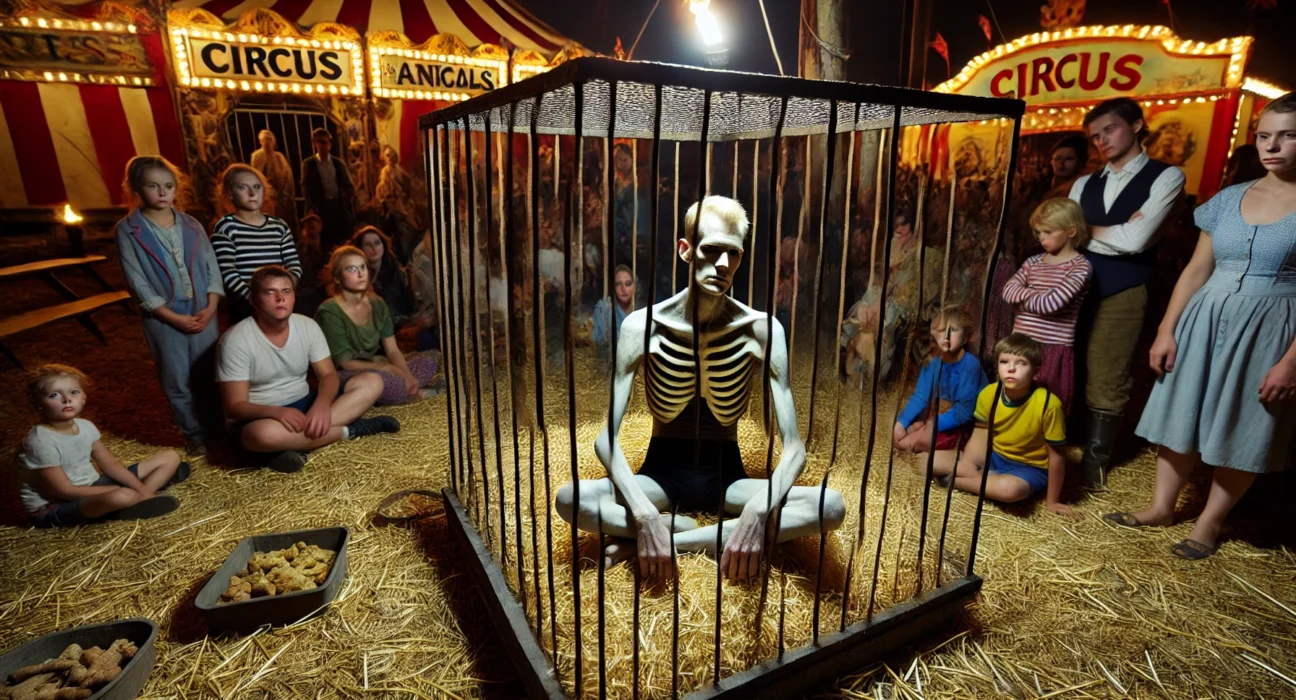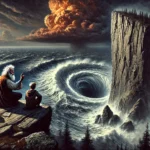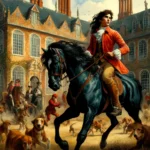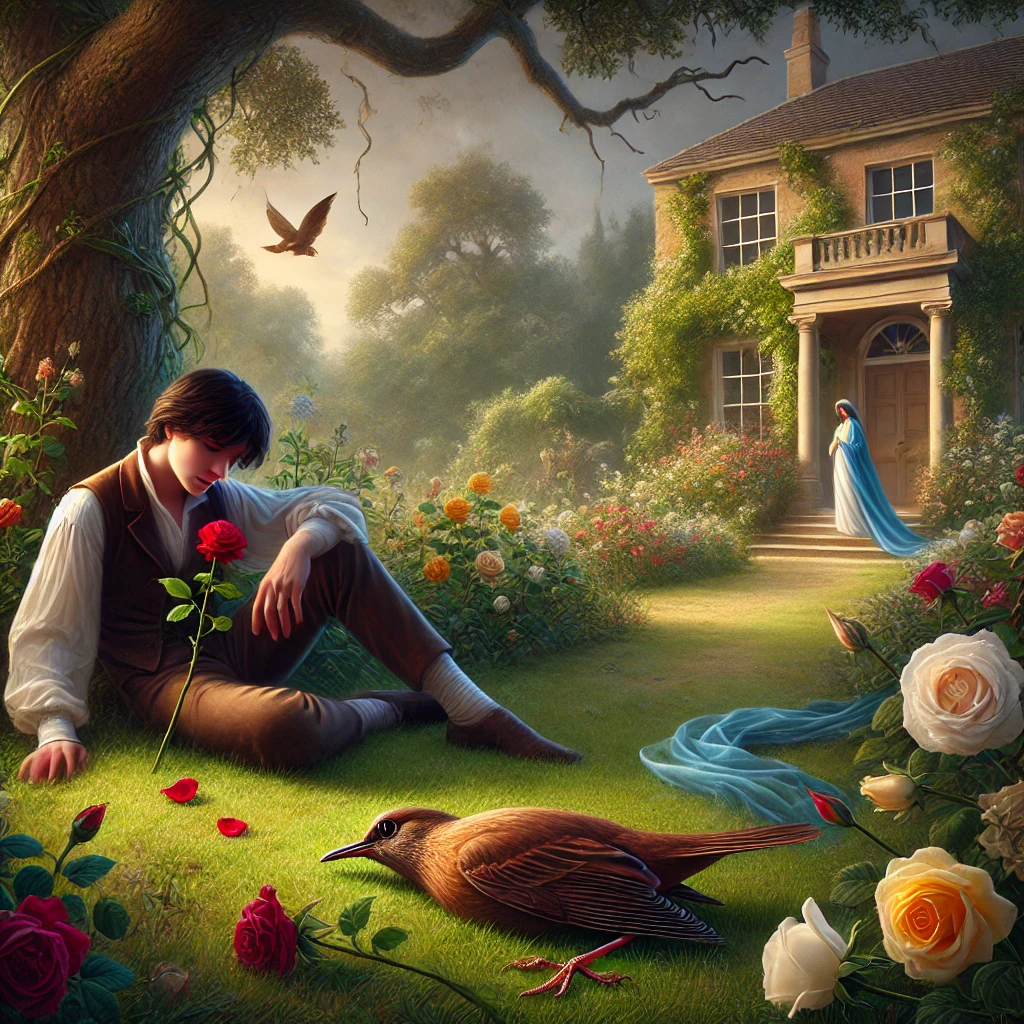“A Hunger Artist” is a short story by Franz Kafka, first published in 1922. It delves into the life of a professional hunger artist, a man who fasts for extended periods as a form of public spectacle. The story is a haunting meditation on art, isolation, and the insatiable human desire for recognition and meaning. As Kafka often does, he explores themes of alienation and the existential burden of life through the lens of absurdity, creating a narrative that is both surreal and deeply tragic.
Plot Summary
The artist sat behind bars, his skeletal figure perched on a bed of straw, his gaunt face peering through the iron slats of his cage. For days on end, sometimes weeks, he fasted, drinking nothing but water, eating nothing at all, as spectators filed by to observe him. He wore a tight black suit that clung to his bones, his ribcage pressing through his skin, while his eyes held a steady, distant gaze.
Once, fasting had been an art. Crowds would gather in the hundreds, even thousands, to witness the spectacle of a man who could deny himself sustenance for the purest reason: devotion to his craft. The artist relished the attention in those days, not for the recognition of fame, but for the hope that someone—anyone—would understand the significance of his act. Children watched in awe, wide-eyed and innocent, their mouths agape in wonder. Adults, more skeptical, would debate whether his feat was genuine. Could a man really live without food for so long?
To reassure the doubters, three watchmen, often butchers, were assigned to keep vigil by the cage day and night. Their duty was to ensure that no secret morsels were passed to the artist, that his fast was true. They carried out their task half-heartedly, gathering in distant corners of the room to play cards and chat, unconcerned with the artist’s torment. But it wasn’t the physical deprivation that pained him; it was the suspicion, the thought that his commitment was questioned. He would sometimes break into song, his weak voice trembling in the night, to prove to them that he was not eating in secret. But the song only made the watchers believe he was more skilled at deception than they’d thought.
Despite these misunderstandings, the hunger artist thrived during these days, for at least the city still cared. Spectators lined up, eager to see the spectacle of starvation. On the fortieth day of each performance, a ceremonial ending was staged. The artist was led out of his cage by two young women selected by lot, though his body resisted, weak from hunger. He fought internally, never understanding why he had to stop. He could fast longer—much longer. The doctors would announce their findings to the crowd, confirming the artist’s deteriorated condition, and then he would be fed. But even the thought of food nauseated him, a truth he kept to himself, forcing a smile for the sake of those around him.
In the years that followed, the hunger artist’s popularity began to fade. What was once a revered form of entertainment gradually lost its appeal. His impresario, always calculating the public’s interests, could see the decline. People no longer flocked to see the man in the cage. They preferred newer forms of entertainment, leaving the hunger artist to fast unnoticed, his craft slipping further into obscurity.
Eventually, the impresario, understanding that the artist’s time had passed, let him go. The hunger artist, now older and without the means to support his performances, turned to a circus. There, he was hired for a modest wage and placed in a small cage near the animal stalls, out of the way of the main attractions. His once-glorified performances were reduced to a sideshow that visitors barely noticed as they rushed to see the lions and elephants.
Still, the hunger artist continued fasting, day after day, though his efforts went unacknowledged. The crowd no longer cared to stop and observe him. Those who did were more interested in getting through the passage to the animals. They gave him fleeting glances, if any at all. His art had become irrelevant, and he himself became invisible. Yet, he persisted. He fasted for longer than ever before, unbound by the forty-day limit once imposed by his impresario. No one counted the days now. No one tracked his progress. His achievement, he realized, meant nothing without an audience.
Time passed, and even the attendants at the circus began to neglect him. The sign that marked the number of days he had been fasting grew dirty and faded, left unchanged. The artist, skeletal and hollow-eyed, still sat in his cage, committed to his fast. Visitors trickled by, unaware that the man before them had not eaten in an unimaginable length of time. His cage, once a place of performance, became a forgotten relic in the shadow of the circus animals.
One day, a supervisor passing through the grounds noticed the cage in disrepair. The straw beneath the artist had rotted, and the once-bright signs were barely legible. He inquired about the state of the cage and was surprised to learn that it still housed the hunger artist. No one had thought to check on him in weeks, possibly longer. Curious, the supervisor prodded the straw with a stick, revealing the emaciated body of the artist lying beneath.
The supervisor leaned closer to hear the artist’s final words. The artist confessed that fasting was easy, that his life had been shaped not by a desire to starve but by the inability to find food he enjoyed. If he had found that food, he would have eaten like everyone else. With those last words, the hunger artist slipped into death, his frail body finally still.
Unceremoniously, the cage was cleared, and the hunger artist was buried with the straw. The circus, always in need of fresh attractions, filled the cage with a young panther. The new occupant was lively, powerful, and filled with an appetite for life. The crowd, drawn by the panther’s vigor and energy, pressed in to watch as the beast prowled the cage, its gleaming muscles a stark contrast to the frail man who had once occupied the space. The panther, content with its meals, basked in its freedom, thrilling the spectators who gathered to witness its wild vitality.
The hunger artist, once admired and misunderstood, was now forgotten, replaced by the spectacle of the panther’s raw, unbridled energy. The world had moved on, leaving his silent struggle behind.
Main Characters
The Hunger Artist: The central figure of the story, he is a man whose identity is defined by his ability to fast for long periods. He views fasting not only as a skill but as an art form, even though few understand or appreciate his passion. His yearning for recognition, combined with the alienation he feels from the world, leads him to a life of increasing despair.
The Impresario: The manager of the hunger artist’s performances, the impresario is pragmatic, always more concerned with the commercial aspect of the spectacle than the deeper meaning that the hunger artist ascribes to his fasting. He represents society’s superficial engagement with art, where spectacle takes precedence over substance.
The Circus Supervisor: In the latter part of the story, after the hunger artist’s career has faded, the circus supervisor represents society’s complete indifference to the artist. He discovers the artist’s emaciated body after neglecting him for too long, serving as a symbol of how the world moves on from what it no longer values.
Theme
The Isolation of the Artist: The hunger artist is profoundly isolated, both physically and emotionally. His fasting cage represents the separation between him and the audience, a barrier that grows insurmountable as time progresses. His audience never truly understands his art, deepening his sense of loneliness.
The Nature of Art and Suffering: Kafka explores the relationship between suffering and art. The hunger artist’s work is a form of self-denial, and he believes that true art requires this extreme devotion. However, the world does not appreciate his sacrifice, leading him to question whether his suffering has any meaning.
The Search for Authenticity: The hunger artist is obsessed with the purity of his craft. He feels unfulfilled because he is never able to achieve the perfect fast—partly because of the imposed limits and partly because the world around him doesn’t grasp the depth of his endeavor. This motif highlights the conflict between an artist’s internal standards and external recognition.
The Indifference of Society: As the artist’s career wanes, the story highlights how society moves on from old spectacles and trends. The once-popular hunger artist is forgotten, neglected in the back of a circus, symbolizing society’s fleeting interest in art and how quickly it turns to new forms of entertainment.
Writing Style and Tone
Kafka’s writing in “A Hunger Artist” is characteristically precise and detached, with a tone that veers between the tragic and the absurd. The narrative is straightforward, often dry, but this simplicity masks profound existential questions. The third-person narration keeps the reader at a distance, mirroring the hunger artist’s own alienation from society. Kafka uses simple language and descriptions to create an atmosphere of bleakness, intensifying the emotional weight of the story’s central themes.
The tone of the story is somber, with Kafka emphasizing the futility of the hunger artist’s efforts. There’s an underlying sense of existential dread, as the artist’s life and work go largely unappreciated by a world that is indifferent to the deeper meaning he strives for. Kafka’s use of irony is also notable, particularly in how the artist’s suffering is met with indifference or misunderstanding, leading to a conclusion that is as absurd as it is tragic.
We hope this summary has sparked your interest and would appreciate you following Celsius 233 on social media:
There’s a treasure trove of other fascinating book summaries waiting for you. Check out our collection of stories that inspire, thrill, and provoke thought, just like this one by checking out the Book Shelf or the Library
Remember, while our summaries capture the essence, they can never replace the full experience of reading the book. If this summary intrigued you, consider diving into the complete story – buy the book and immerse yourself in the author’s original work.
If you want to request a book summary, click here.
When Saurabh is not working/watching football/reading books/traveling, you can reach him via Twitter/X, LinkedIn, or Threads
Restart reading!








